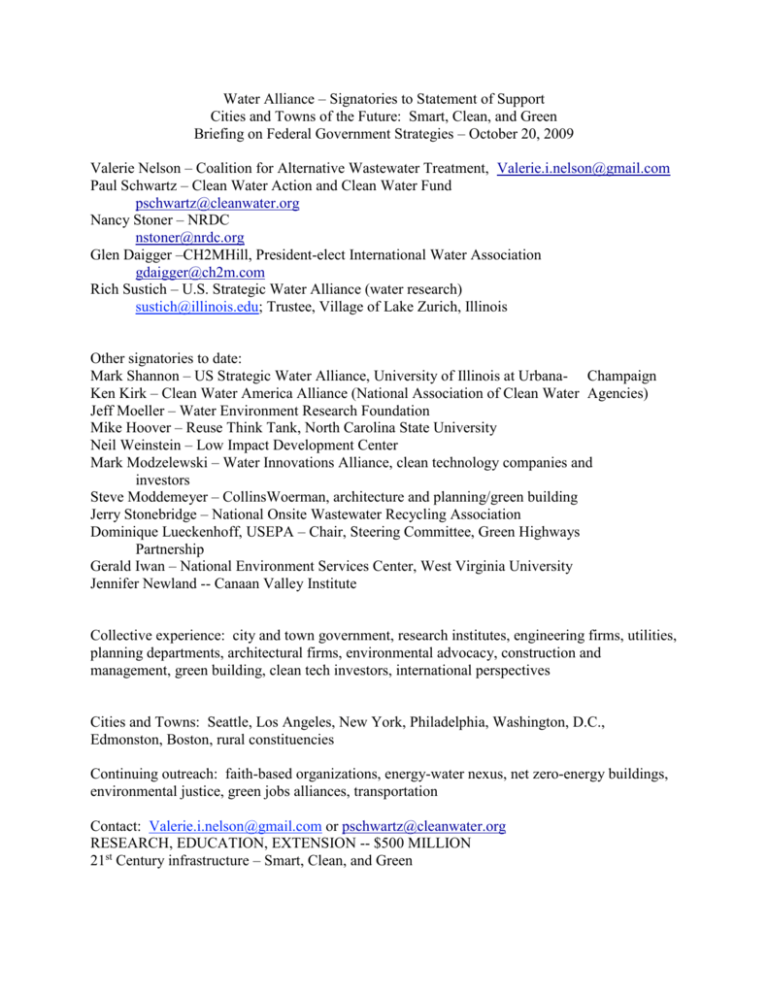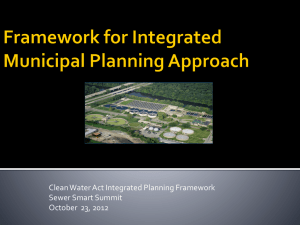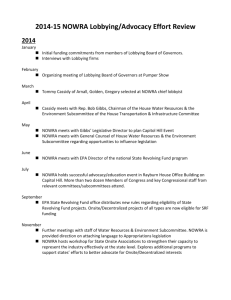Infrastructure Challenge Grants
advertisement

Water Alliance – Signatories to Statement of Support Cities and Towns of the Future: Smart, Clean, and Green Briefing on Federal Government Strategies – October 20, 2009 Valerie Nelson – Coalition for Alternative Wastewater Treatment, Valerie.i.nelson@gmail.com Paul Schwartz – Clean Water Action and Clean Water Fund pschwartz@cleanwater.org Nancy Stoner – NRDC nstoner@nrdc.org Glen Daigger –CH2MHill, President-elect International Water Association gdaigger@ch2m.com Rich Sustich – U.S. Strategic Water Alliance (water research) sustich@illinois.edu; Trustee, Village of Lake Zurich, Illinois Other signatories to date: Mark Shannon – US Strategic Water Alliance, University of Illinois at Urbana- Champaign Ken Kirk – Clean Water America Alliance (National Association of Clean Water Agencies) Jeff Moeller – Water Environment Research Foundation Mike Hoover – Reuse Think Tank, North Carolina State University Neil Weinstein – Low Impact Development Center Mark Modzelewski – Water Innovations Alliance, clean technology companies and investors Steve Moddemeyer – CollinsWoerman, architecture and planning/green building Jerry Stonebridge – National Onsite Wastewater Recycling Association Dominique Lueckenhoff, USEPA – Chair, Steering Committee, Green Highways Partnership Gerald Iwan – National Environment Services Center, West Virginia University Jennifer Newland -- Canaan Valley Institute Collective experience: city and town government, research institutes, engineering firms, utilities, planning departments, architectural firms, environmental advocacy, construction and management, green building, clean tech investors, international perspectives Cities and Towns: Seattle, Los Angeles, New York, Philadelphia, Washington, D.C., Edmonston, Boston, rural constituencies Continuing outreach: faith-based organizations, energy-water nexus, net zero-energy buildings, environmental justice, green jobs alliances, transportation Contact: Valerie.i.nelson@gmail.com or pschwartz@cleanwater.org RESEARCH, EDUCATION, EXTENSION -- $500 MILLION 21st Century infrastructure – Smart, Clean, and Green Research Agendas: Water Availability and Quality – OSTP inter-agency group, September 2007 (House bill – stalled in Senate) WERF – Smart, Clean, and Green – February, 2009 National Academy of Sciences – September, 2009 U.S. Strategic Water Initiative – October, 2009 Excerpt from December, 2008 letter to Congressional committees re funding for “lab-ready” jobs: We recommend the following allocation of $100 million to national research and development programs coordinated by EPA: $10 million for a second year of EPA’s sustainable infrastructure research program; $10 million for the Water Environment Research Foundation (including $3 million for the Congressionallyauthorized National Decentralized Water Resources Capacity Development Project based at WERF); $10 million for Drinking Water Research at the Water Research Foundation; $1 million for the Science Committee-recommended project on “soft path” water infrastructure at the National Academy of Sciences; $5 million for water-related research led by EPA in the Zero-Net Energy Building research initiative; $14 million for EPA’s water-climate research agenda; $40 million for an EPA-National Science Foundation collaboration in applications of emerging science to innovative water treatment technologies; and $10 million to other discretionary research and education programs at EPA, including $3 million for the National Small Flows Clearinghouse of the National Environmental Services Center at West Virginia University. An additional $100 million should be allocated to applied research in other federal agencies, which have in the recent past explored innovative technologies and designs in water management. Information on the mission and activities of these research programs can be found at: http://sustainablewaterforum.org/fed/cat.pdf. Funding for these “ready” programs and research institutions across the country could include: $25 million for the Department of Agriculture – Cooperative State Research, Education, and Extension Service (CREES) and U.S. Forest Service – Urban Forestry; $15 million for the Department of Commerce -- National Sea Grant College Program, National Estuarine Research Reserves, and National Institute of Standards and Technology $15 million for the Department of Defense – National Environmental Technology Test Sites $15 million for the Department of Energy – Energy Efficiency and Renewable Energy-water nexus $5 million for the Department of Health and Human Services – Centers for Disease Control – National Center for Environmental Health $3 million for the Department of Housing and Urban Development – Partnership for Advancing Technology in Housing (PATH) $20 million for the Department of the Interior -- Bureau of Reclamation Water Reclamation and Reuse Program and USGS – National Institutes for Water Resources $2 million for the Department of Transportation – Green Highways Initiative. INFRASTRUCTURE CHALLENGE GRANTS -- $1 BILLION Cities and Towns – Smart, Clean, and Green Primary agencies: EPA, DOE Secondary agencies: USDA (Forest Service/RUS), HUD, DOT, Commerce Fundamental redesign of integrated urban infrastructure services (vs. “green reserve” in Clean Water SRF, which funds siloed approaches in green infrastructure or water efficiency or energy efficiency or decentralized wastewater; vs. Green Impact Zone, which targets diverse agency budgets on a neighborhood – but which has broader funding streams, focus on energy – weatherization, smart grid) Integrated infrastructure design – water, wastewater, stormwater, energy, solid waste, transportation Embedded or nested into building and neighborhood scales Repurposed central system infrastructure Efficiencies and recovered resources – work with and mimic nature Examples – non-potable reuse, biogas recovery and sewer heat mining, green roofs, stream restoration, rainwater harvesting, nutrient recovery into gardens – “eco-block” Multiple benefits/outcomes: Lighter environmental footprint – lower per capita potable water use, energy consumption and carbon footprint Ecosystem restoration – water returned to natural systems, restored hydrologies Healthier communities – air quality, lowered temperatures, green space, clean water, removal of toxics, community gardens/nutrient recovery Lower costs of services – synergy of integrated designs Economic benefits – neighborhood revitalization, green jobs Public-private financing – costs of infrastructure partly absorbed into building construction, private utilities Phase I: planning and design Review: technical designs and benefits/outcomes Phase II: construction Examples: Los Angeles – Andy Lipkis, TREE People Seattle – Steve Moddemeyer, CollinsWoerman New York – Ed Clerico, Battery Park and Co-op Housing FUNDING – Break Down Silos in Current Funding and Expand Market Transformation Strategies I. Infrastructure grants and loans to municipalities – wastewater, water, stormwater, energy, transportation, buildings, schools, hospitals, housing Changes in Guidelines: Expand eligibilities for innovative approaches that “lighten footprint” Provide incentives (additional subsidization) for innovative approaches Require integrated resource plan as a condition of grant or loan Require calculations of full range of benefits and costs to public health, environment, economy Radical concept – fund only “21st Century systems” EPA – Clean Water and Safe Drinking Water SRF’s USDA – Rural Development/RUS wastewater grants and loans – currently restricted to “publicly-owned facilities” except in a few branch offices HUD – Community Development Grants EDA – infrastructure grants/loans Army Corps Bureau of Reclamation II. Market Transformation Strategies – “Just Add Water” to Energy approaches Federal facilities – October 5, 2009 Federal Leadership in Environmental, Energy, and Economic Performance – includes all “categories” – could stress importance of recovering energy from wastewater stream, could aim for lowering “water footprint” Standards and labeling – EPA needs to work on non-potable reuse standards, in particular Tax incentives for builders and homeowners Clean technology support – Small Business Administration, venture capital loans, etc. Green collar job education and training programs Portfolio standards for municipalities – water-efficiency or reuse – reduction in potable water use REGULATORY REFORM – 21ST Century Infrastructure Integrated – water, energy, solid waste, transportation Embedded or nested in buildings and neighborhoods, along with repurposed Centralized infrastructure Federal level: siloed, point-source permits: NPDES permits – wastewater treatment plants SDWA – public water supply systems Long-term control plans – CSO’s and MS-4’s for stormwater runoff Army Corps – flood and sediment control Endangered Species Act Missing: Nonpoint sources, integrated planning (water quality and quantity) State and Local Level regulations and permitting: Water withdrawals Groundwater discharge permits (underground injection controls) Building codes Septic system regulations Zoning and land Use Problems with Existing Approach Sewer bias – vs. decentralized approaches (EPA pushes communities into NPDES program) Storm sewer bias –vs. green infrastructure, stormwater retention Short timeframes for alternatives analysis – public attention too late Siloed actions – without consideration for whole water system impacts Financial risks for innovation – local community, engineer are risk-averse Failure to consider full range of potential health and community benefits Inefficiencies in priority-setting – need a watershed approach Opportunities for Incremental Reform: Question whether increased enforcement within existing system is best strategy Disconnect OMB performance ratings from narrow permit listings (EPA is sewering-up small communities in order to achieve higher scores) Develop model consent decrees/long-term control plans (stormwater) that incorporate adaptive management, somewhat less in effluent control but significantly higher community and public health benefits – Daigger – Syracuse and Louisville; Nancy Stoner – Philadelphia/EPA Headquarters TMDL’s with groundwater discharge permits – Valerie Nelson/Paul Schwartz – model for Cape Cod towns/Conservation Law Foundation – EPA should be taking the lead in dealing with nonpoint-source wastewater into groundwater/surface water Long-term goal for integrated infrastructure: Sustainability Act – multiple benefits and outcomes as performance goalsIncremental recommendations: 1. HUD-DOT-EPA collaboration for Livable Communities Initiative re stormwater, transportation – add DOE, USDA for energy, water, wastewater, reuse 2. EPA’s Urban Water Initiative – incorporate 21st Century water infrastructure concepts, including energy, wastewater, reuse infrastructure 3. Chesapeake Bay Program – incorporate 21st Century water infrastructure concepts, including energy, wastewater, reuse infrastructure 4. EPA -- Merge WaterSense, green infrastructure, decentralized wastewater programs in the Office of Water 5. EPA – provide additional funding for Sustainable Infrastructure Research grant to WERF, and include funding for Decentralized Water Resources Collaborative (NDWRCDP) 6. EPA – increase research funding for green infrastructure 7. EPA – request agency to develop a model budget and workplan to incorporate significant “research and development” and “extension activities” into its mission 8. EPA – continue permit-writing exercise for green infrastructure/CSO’s and initiate work on groundwater discharge/TMDL’s for wastewater 9. EPA – update national standards and guidelines for non-potable reuse 10. USDA – request Rural Development to take branch office approach to financing private infrastructure to the national level 11. USDA – expand funding for CREES to expand into smart, clean, green infrastructure 12. Army Corps of Engineers – expand consideration of multiple benefits and outcomes 13. DOE – fully explore potential energy recovery from wastewater stream and water system 14. DOE – emphasize water infrastructure in federal facilities and net zero-energy initiatives









